Captivating imagery from NASA‘s James Webb Space Telescope (JWST) has provided an unprecedented view into the star-forming region NGC 604, revealing the life cycle of stars in exquisite detail. The latest visuals showcase the awe-inspiring complexity within the star nursery located in the Triangulum galaxy. This cutting-edge data allows researchers to probe the birth of stars and the myriad forces shaping their formation, advancing our understanding of the cosmos.
Star formation and the intricate environments surrounding it have long been a focal point of celestial studies. NGC 604, a particularly intriguing region, has been observed by astronomers for years, with each generation of telescopes peeling back new layers of its mystery. Prior images taken by the Hubble Space Telescope offered limited views of the nebula’s structure. More recently, the JWST has provided a clearer picture, giving insights into the nebula’s cavernous bubbles and filamentary gas patterns, which suggest a more dynamic star birth process than previously understood.
Webb’s NIRCam Unveils Stellar Birth Environments
The NIRCam images from Webb reveal bright red tendrils and clumps, extending from bubble-like clearings in the nebula. These features are carved by stellar winds from the most brilliant young stars, which have also ionized the surrounding gas, producing a ghostly blue glow. The NIRCam’s resolution has shed light on previously isolated features, now understood to be part of the nebula through connections of diffuse red gas.
MIRI Offers a New Perspective on Cosmic Dust and Gas
Complementing the NIRCam, Webb’s Mid-Infrared Instrument (MIRI) presents a contrasting view of NGC 604. At these wavelengths, cooler gas and dust become more prominent. Stars, especially red supergiants, appear less bright but larger. Hot stars emit less light in mid-infrared, allowing for a clearer visualization of the cooler, star-forming regions and the glowing carbon-based molecules known as PAHs.
Other publications have also chronicled NGC 604’s stellar activity. For instance, an article titled “Webb’s First Deep Field” on NASA’s official website explores how JWST’s powerful instruments capture sharp and deep views of distant galaxies, aiding in the study of early star formation. Another relevant piece, “JWST to Study Forming Stars in Nearby Galaxies” from Space.com, discusses plans to use JWST to observe star-forming regions in galaxies close to the Milky Way, underscoring the significance of JWST’s observations of NGC 604 within the broader context of galaxy evolution and star formation research.
Webb’s Mission Continues to Illuminate the Cosmic Ballet of Star Formation
Estimated to be around 3.5 million years old, NGC 604’s glowing gas cloud spans roughly 1,300 light-years. The James Webb Space Telescope, representing an international collaboration, continues to probe the mysteries of our solar system and the universe at large. Webb’s powerful gaze extends from our own celestial neighborhood to the farthest reaches of space, offering unparalleled insights into our place within the cosmos.
NASA’s James Webb Space Telescope has paved the way for new discoveries in NGC 604, offering an intimate look at the birthplaces of stars. As someone with a deep interest in astrophysics, these revelations are exhilarating. The phenomena observed by JWST—from the massive stars‘ early stages to the intricate interplay of gas and dust—highlight the dynamic nature of our universe. Understanding how these celestial bodies come into existence not only satisfies our curiosity but also holds clues to the origins of our solar system and potentially life itself. It’s a profound reminder that there’s still so much more to explore and comprehend about the vast expanse above us.










